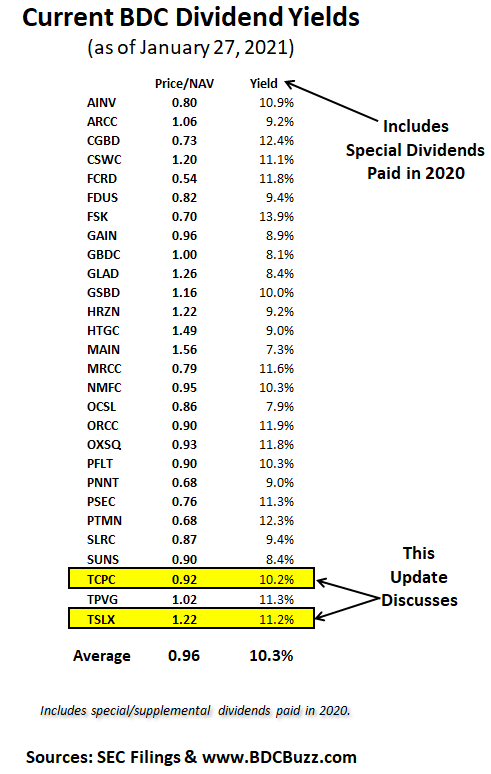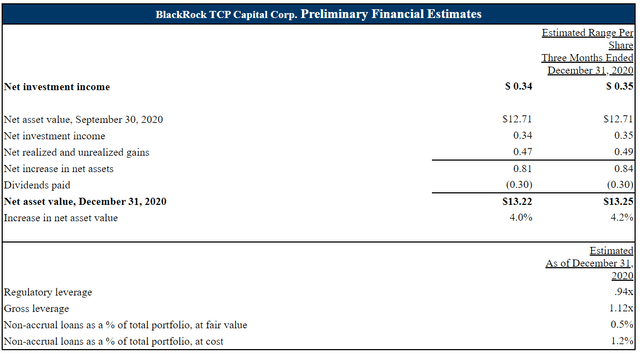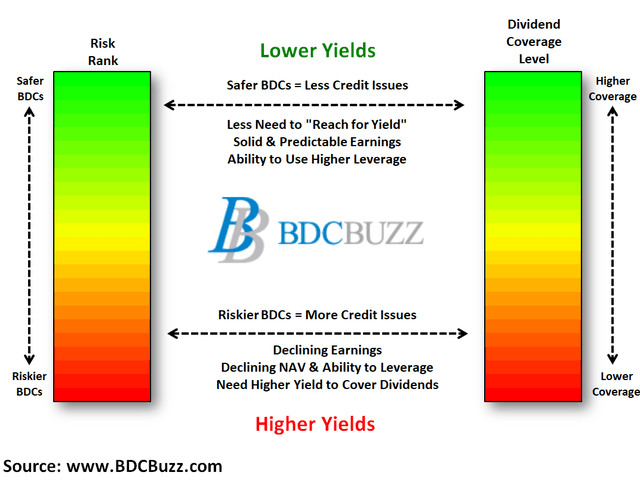

TSLX Preliminary Estimates
- NAV increase of almost 2%
- NII of $0.48 compared to its dividend of $0.41
- Stable portfolio credit quality with 0.9% non-accruals
As of January 25, 2021, Sixth Street Specialty Lending, Inc. (TSLX) estimates that its net asset value per share as of December 31, 2020 was approximately $17.16 per share, up from $16.87 as of September 30, 2020 (or $16.77 after adjusting for the impact of the Company’s Q3 2020 supplemental dividend that was paid on December 31, 2020). As of December 31, 2020, the Company’s total portfolio was approximately $2.3 billion in aggregate fair value, up from $2.1 billion as of September 30, 2020.
Estimated net income per share for the quarter ended December 31, 2020 is $0.79. Estimated net investment income per share for the quarter ended December 31, 2020 is $0.48. Both these amounts include approximately $0.02 per share of incentive fee expenses that were accrued, but not paid, related to the Company’s cumulative inception-to-date unrealized gains exceeding its cumulative inception-to-date realized gains and losses and unrealized losses as of December 31, 2020. Excluding the impact of the accrued capital gains-related incentive fee expenses, the Company’s estimated net income per share and net investment income per share for the quarter ended December 31, 2020 were $0.81 and $0.50, respectively.
As of December 31, 2020, the Company had approximately $865 million of liquidity in undrawn debt capacity and unrestricted cash. During the fourth quarter, the Company added $20 million of commitments to its senior secured revolver, bringing total capacity to $1.335 billion as of December 31, 2020. Estimated debt to equity as of December 31, 2020 was approximately 0.95x, up from 0.81x as of September 30, 2020. The Company’s debt funding mix at quarter end was comprised of approximately 58% unsecured debt, and the Company had approximately $863 million of undrawn capacity under its revolving credit facility.
There has been no material change to the Company’s weighted average portfolio performance ratings from September 30, 2020, to December 31, 2020. As of December 31, 2020, investments on non-accrual status was approximately 0.9% of the portfolio at fair value, flat from the prior quarter. During the quarter ended December 31, 2020, one additional portfolio company was placed on non-accrual status, American Achievement Corporation. The Company’s investments in MD America Energy, LLC and J.C. Penney Company, Inc. were removed from non-accrual status.

BlackRock TCP Capital (TCPC) announced preliminary financial estimates for the fourth quarter ended December 31, 2020.
- NAV increase of 4%
- NII of $0.34 to $0.35 compared to its dividend of $0.30

Full BDC Reports
This information was previously made available to subscribers of Premium BDC Reports, along with:
- TSLX and TCPC target prices and buying points
- TSLX and TCPC risk profile, potential credit issues, and overall rankings
- TSLX and TCPC dividend coverage projections and worst-case scenarios
- Real-time changes to my personal portfolio
BDCs trade within a wide range of multiples driving higher and lower yields mostly related to portfolio credit quality and dividend coverage potential (not necessarily historical coverage). This means investors need to do their due diligence before buying.

To be a successful BDC investor:
- Identify BDCs that fit your risk profile.
- Establish appropriate price targets based on relative risk and returns (mostly from regular and potential special dividends).
- As companies report results, closely monitor dividend coverage potential and portfolio credit quality.
- Diversify your BDC portfolio with at least five companies. There are around 45 publicly traded BDCs; please be selective.

